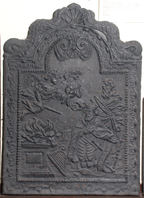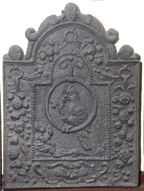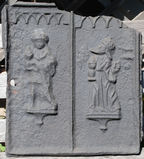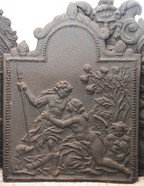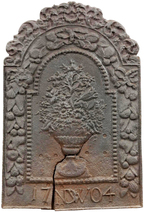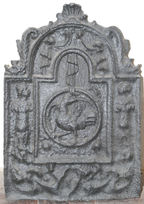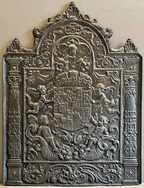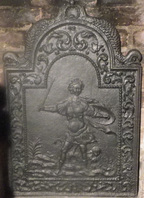-
424
Description: Arched rectangular central panel with bead edging terminating at the top in two loops, gather drapery and a scallop shell; two figures to the right, both bearded, the one kneeling wears cavalry armour, a cloak and a crown, the other stands behind; to the left is a sacrificial pyre on which an ox carcass burns, and above an angel carrying a sword in his right hand and a skull in his left; around this is an arched rectangular border with fillet edging and a repeated leaf pattern; on top is a scallop shell between two dolphins.
Notes: The scene illustrates the visitation of the pestilence on Israel described in 2 Samuel 24, and the sacrifice of an oxen by King David; the skull borne by the angel represents the death of those struck down by the plague. A slightly different version has the face of David looking down (no. 527). Formerly part of the J. H. Every collection.
Copies of this fireback are known.
Manufactured: in the mid- to late-17th century in the Siegerland area of Germany.
Current location: Anne of Cleves House, Southover High Street, Lewes, East Sussex, England.
Museum number: 1944.24.070 (part of the Sussex Archaeological Society museum group)
Citation: Hughes, G. B., 1960, Collecting Antiques (London, Country Life), pp. 85-93.
-
426
Description: Arched rectangular central panel with bead edging; suspended from the top, by a ribbon, a ring with a popinjay, or parrot, perched thereon, biting a twig in its right claw; below left is a seated child; around this panel is an arched rectangular border with fillet edging containing floral swags hung on ribbons suspended from rings; on top, two serpents.
Notes: A common design among firebacks produced in Germany for the Dutch market. Formerly part of the J. H. Every collection.
Copies of this fireback are known.
Manufactured: in the mid- to late-17th century in the Siegerland area of Germany.
Current location: Anne of Cleves House, Southover High Street, Lewes, East Sussex, England.
Museum number: 1944.24.072 (part of the Sussex Archaeological Society museum group)
- Attached to series:
- 'Dutch' Miscellaneous Firebacks
- 'Dutch' Bird on perch firebacks
-
434
Description: Damaged; rectangle, flanged edging; two vertical panels, each with a row of lancet arches along the top: on right, robed figure with a crown, head tilted to left, left hand raised in benediction, right hand holding a chalice, standing on a bracket; on right, similar figure facing forward.
Notes: Stoveplate. Similar plates suggest these may be two of the Magi.
- Decoration tags:
- rectangular (shape)
- flanged (edging)
- simple stamps
- architectural
- humans
Manufactured: in the early-16th century in the Eifel area of Germany.
Current location: Anne of Cleves House, Southover High Street, Lewes, East Sussex, England.
Museum number: LH000.795 (part of the Sussex Archaeological Society museum group)
Citation: Dawson, C., 1903, 'Sussex Iron Work and Pottery', Sussex Archaeological Collections, 46, pp. 1-54.
- Attached to series:
- Stoveplates
- Figurine firebacks
-
446
Description: Arched rectangular; bead edging; pictorial scene of Venus, naked and kneeling, and Adonis, standing, holding a spear in his left hand, with Cupid to the left, and a hound to the right; pomegranates on top and on each shoulder of the plate, with two symmetrical, descending serpents.
Notes: Probably based on one of two paintings of Venus and Adonis by Peter Paul Rubens.
Copies of this fireback are known.
- Decoration tags:
- 'Dutch' (shape)
- bead (edging)
- whole carved pattern
- pictorial
- mythological
- humans
Manufactured: in the mid- to late-17th century in the Siegerland area of Germany.
Current location: Anne of Cleves House, Southover High Street, Lewes, East Sussex, England.
Museum number: LH000.971 (part of the Sussex Archaeological Society museum group)
- Attached to series:
- 'Dutch' Borderless series
- 'Dutch' Venus and Adonis firebacks
-
476
Description: Arched rectangular central panel with bead edging; pictorial scene of a stork dipping its beak into a tall pot, a fox close by, a tree to the right; arched rectangular border with fillet edging; at top, a double clasp with descending ribbon on each side from which are suspended, via rings, a shield, trumpets and an armoured torso; at the bottom, an oval cartouche between two blocks; on the top, a central pomegranate between two descending sea serpents, and a pomegranate on each shoulder of the plate.
Notes: The scene illustrates one of Aesop's Fables.
- Decoration tags:
- 'Dutch' (shape)
- fillet (edging)
- whole carved pattern
- pictorial
- mythological
- animals
- objects
Manufactured: in the mid- to late-17th century in the Siegerland area of Germany.
Current location: Maidstone Museum, St Faith's Street, Maidstone, Kent, England.
(part of the Maidstone Museum museum group)
- Attached to series:
- 'Dutch' Miscellaneous Firebacks
-
1275
Description: Arched rectangular central panel with bead-on-fillet edging; central vase containg a variety of flowers and foliage; arched rectangular border with fillet edging containing two arrangements of fruit and leaves descending on each side from ribbons, and with ribbons at the shoulders; at the bottom, the monogram 'NDW' between the two halves of the date; above the arch, descending scrolled foliage.
Notes: This fireback differs in its form from others with the NDW monogram and is closer to an English form seen in the TAN series, albeit considerably smaller.
Inscription: 17 NDW 04
- Decoration tags:
- 'Dutch' (shape)
- fillet (edging)
- whole carved pattern
- individual numbers
- pictorial
- monogram
- text
- plants
- objects
Manufactured: in 1704 possibly in the Siegerland area of Germany.
Current location: not known.
- Attached to series:
- 'Dutch' NDW series
-
489
Description: Arched rectangular central panel with additional arch above; bead and fillet edging; pictorial scene of Solomon, rising from a scallop-backed, canopied throne, greeting the Queen of Sheba, with other figures in attendance; identical shaped border with cavetto-moulded edging; a vase on top with descending swags of drapery; at the sides, overlapping bunches of foliage suspended from ribbon bows; at the bottom, a central cartouche between fruit bunches; on top, a pomegranate with a descending serpent on each side, and a pomegranate on each shoulder of the plate.
Notes: Several contemporary paintings are of similar scenes; this design may have been derived from any of them. Close observation shows that the scene depicted, and some other decorative elements, are different to those on a similar fireback, no. 1289.
Copies of this fireback are known.
Manufactured: in the mid- to late-17th century in the Siegerland area of Germany.
Current location: Michelham Priory, Arlington, East Sussex, England.
(part of the Sussex Archaeological Society museum group)
-
492
Description: Arched rectangular central panel; fillet and ovolo edging; a ring suspended with drapery, supporting a bird, its wings displayed and inverted, looking to the right, with a small roundel below it in each corner; arched rectangular border with fillet edging, and symmetrical drapery in the arch; and indistinct figure on each side, and indistinct foliage below; on top, a scllop shell between two descending serpents.
Notes: A bird, usually a parrot, perching on a suspended ring can be seen on other firebacks produced in the Siegerland for the Dutch market in the latter part of the 17th century.
Copies of this fireback are known.
Manufactured: in the late-17th century in the Siegerland area of Germany.
Current location: Michelham Priory, Arlington, East Sussex, England.
(part of the Sussex Archaeological Society museum group)
- Attached to series:
- 'Dutch' Miscellaneous Firebacks
- 'Dutch' Bird on perch firebacks
-
1203
Description: Arched rectangular central panel with bead on fillet edging; central shield of the Dutch house of Orange impaling English royal Stuart, surmounted by a crown and supported by two putti; above, a maske with two descending grape bunches; below, two more putti seated on scrolls and cornucopiae; a drapery swag and bow in each top corner; arched rectangular border with cavetto-moulded edging and canted top corners; on each side, a Corinthian column and entablature on a pedestal, the columns with floriate decoration; below, a symmetrical swirled design; above the arch, from a scallop shell on each shoulder, two serpents rising towards a third scallop on top.
Notes: The arms are of William IV Prince of Orange (1650-1702) impaling those of his wife, Mary, Queen of Great Britain. Note, these are not the royal arms of William III and Mary II as joint sovereigns, but as Prince and Princess of Orange. William and Mary married in 1677 and Mary died in 1694, so the fireback dates from between 1689, when Mary became Queen, and 1694. A fireback of the same design with the arms of Louis XIV of France is illustrated by Elling and Winkler-Borck, p.213; it has the initials AD in the cartouche above the arch, not visible on this casting.
Arms: William of Orange
Manufactured: in the late-17th century possibly in the Siegerland area of Germany.
Current location: Lassco, Three Pigeons, Milton Common, , Great Milton, Oxfordshire, England.
Citation: Elling, W. & Winkler-Borck, S., 1992, Ofen- und Kaminplatten (Vreden, Hamaland-Museum).
-
710
Description: Arched rectangular central panel with bead edging; figure of a man with a shield, brandishing a sword in his right hand, a lion behind him; arched rectangular border with astragal and fillet edging; mirrored swirled foliate design; on top, a scallop shell between two descending sea serpents.
Notes: The figure is probably Hercules who was charged by Eurystheus to slay the Nemean lion, one of his 12 labours.
Copies of this fireback are known.
- Decoration tags:
- 'Dutch' (shape)
- astragal & fillet (edging)
- whole carved pattern
- pictorial
- mythological
- animals
- humans
Manufactured: in the mid- to late-17th century in the Siegerland area of Germany.
Current location: Great Dixter, Northiam, East Sussex, England.
- Attached to series:
- 'Dutch' Miscellaneous Firebacks
